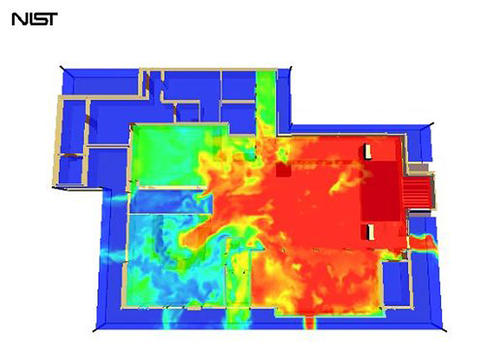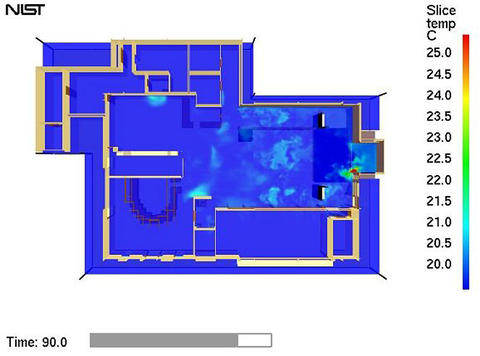- Fact Sheet: Key Findings and Recommendations for Improvement; NIST Investigation of The Station Nightclub Fire
- Presentation on Draft Report on The Station Nightclub Fire Given at March 3, 2005 Press Briefing in Providence, R.I.
- Draft Report of the Technical Investigation of The Station Nightclub Fire
(Note: The presentation and report are presented in .pdf. To read these files, you can download Adobe Acrobat Reader free.) - B-roll of Fire Tests and Simulations (Requires RealPlayer--a free download.
- Archive of Still Images from Computer Models
PROVIDENCE, R.I.— The Commerce Department's National Institute of Standards and Technology (NIST) today called on the organizations that develop building and fire safety codes, standards and practices—and the state and local agencies that adopt them—to make specific changes to improve the fire safety of nightclubs as a result of the agency's investigation of the Feb. 20, 2003, fire at The Station nightclub in W. Warwick, R.I.
Recommendations for changes in nightclubs include requiring sprinklers, tighter restrictions of the use of flammable materials in finish products, and improved means of egress in emergencies. Other recommendations address emergency preparedness and response practices as well as a call for more research to better understand the way people behave in emergency situations such as fires.


All 12 recommendations, contained within the draft report released today for public comment at a press briefing in Providence, are based on the findings of the NIST investigation into the fire that claimed 100 lives. To prevent additional deaths, injuries and property loss in the future, the recommendations call for:
- requiring the installation of sprinkler systems in all new and existing nightclubs regardless of size;
- tightening restrictions for nightclubs on the use of flammable materials as a finish product (such as a wall covering) and further limiting the use of pyrotechnics;
- allowing for more rapid evacuation from nightclubs by changing egress requirements (for example, increasing the capacity of the main exit to accommodate, at a minimum, two-thirds of the maximum permitted number of occupants);
- eliminating the practice of "grandfathering" older nightclubs from new or revised safety regulations;
- requiring redundancy in passive and active fire protection systems for nightclubs;
- considering and incorporating insight gained from similar past building failures when analyzing proposed changes to model codes for nightclubs;
- increasing the number of portable fire extinguishers required in nightclubs;
- implementing more effective fire inspection programs for nightclubs as guided by the model codes;
- ensuring that career and volunteer fire departments meet standards for staffing, equipment, communications systems and major incident/mass casualty incident operating procedures;
- conducting research to better understand human behavior in emergency situations and to predict the impact of building design on safe egress in emergencies;
- conducting research to better understand fire spread and suppression; and
- conducting research to develop and refine computer models and computer-aided decision tools with which communities can make cost-effective choices about code changes, fire safety technologies and emergency resource allocations.
Details on these recommendations are found in the accompanying fact sheet.
The NIST report identifies three factors that directly contributed to the rapid spread of the fire, the resulting building failure and the large loss of life at The Station nightclub. These are: (1) the hazardous mix of building contents; (2) an inadequate capability to suppress the fire early; and (3) the inability of exits to handle the egress of all of the occupants in the short time available with such a fast-growing fire.
Key findings in these three areas are detailed in the accompanying fact sheet.
Video taken inside the nightclub by WPRI-TV (Providence, R.I.) and reporting by the Providence Journal assisted the NIST investigation team.
NIST welcomes comments on the report, available at http://www.nist.gov/public_affairs/ncst.htm#draft_report, which are received by April 4, 2005. (Comment deadline extended to 5 p.m. EDT April 12, 2005.) Comments may be sent via surface mail to The Station Investigation, NIST, 100 Bureau Dr., Stop 8660, Gaithersburg, Md. 20899-8660; via fax to (301) 975-4052; or via e-mail to ncst [at] nist.gov (ncst[at]nist[dot]gov).
NIST's investigation of The Station nightclub fire, begun on Feb. 27, 2003, was conducted under the National Construction Safety Team (NCST) Act. The act gives NIST the responsibility for conducting fact-finding investigations of building-related failures that result in substantial loss of life. NIST has no regulatory authority under the NCST Act.
The primary objectives of the NIST Rhode Island nightclub fire investigation were to:
- determine the conditions in the nightclub prior to the fire, such as the materials of construction and contents;
- the location and conditions of doors, windows and ventilation; the installed fire protection systems; the number of occupants and their approximate locations;
- reconstruct the fire ignition, fire spread and survivability within the building using computer models;
- examine the impact on survivability of having an installed sprinkler system, all other conditions being the same; and
- analyze the emergency evacuation and occupant responses to better understand the impediments to safe egress.
As an agency of the U.S. Department of Commerce's Technology Administration, NIST develops and promotes measurement, standards and technology to enhance productivity, facilitate trade and improve the quality of life.

